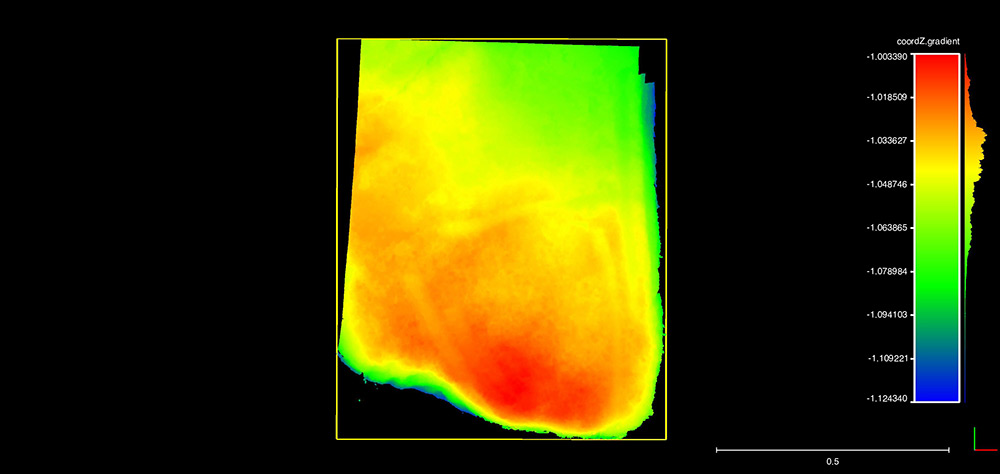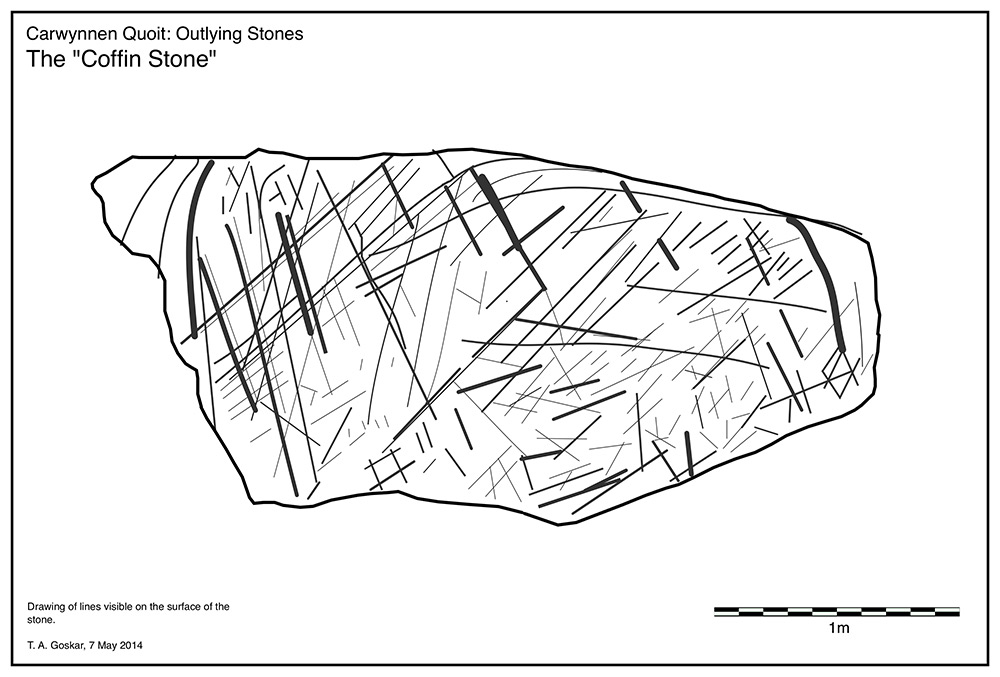This is a summary report about two of the four stones thought to contain rock art or deliberate lines from Frying Pan Field, in the vicinity of Carwynnen Quoit. The data collected and initial interpretation is by Thomas Goskar an Independent Archaeologist.
The “Shield Stone” and “Coffin Stone” were both recorded in 3D using a method known Structure from Motion (SfM), a form of digital photogrammetry, on the morning of 30th April 2014.
The weather was initially dry and overcast, causing little or no shadow to the stone surfaces.
A sequence of overlapping photographs was taken across the areas of interest on both stones. 0.5m and 0.1m scales were included at opposing axes in both image sequences to allow for accurate scaling and checking of units in 3D space.
Shield Stone
The Shield Stone was photographed with a Canon 550D Digital SLR camera equipped with a 50mm prime lens. Image quality was set to high quality JPEG at 18MP (megapixels). Photos were taken freehand at f8 with a shutter speed of 1/90. 158 photos were taken covering the entire stone, to allow for future investigation.
30 photos of the “shield” area of the stone were selected for processing into 3D geometry.
Agisoft PhotoScan was used to align the photos (match points between photos) and remove lens distortion, before computing depth and calculating a point cloud of 3D measurements.
6,318,569 points were generated and exported to an ASCII PLY file, incorporating surface normals.
This file was then opened using CloudCompare to perform scaling and analysis of the carving.
The first technique to be applied to the Shield Stone was PCV Illuminance (Ambient Occlusion). Darker areas of the resulting image are less accessible than the lighter areas - thus parts of the stone containing grooves and pits will be coloured accordingly.

fig 1
The “Shield” shows as being a collection of 5 lines: 3 arcs and 2 lines. The horizontal line is bisected by the vertical seen on the right of figure 1.
Due to the shape of the rock and limited time available for this report, a further vertical groove situated parallel to the line on the far right is not shown, although is captured in this dataset.

Fig 2
The next technique is called range colouring. A scalar field is created along one of the axes (the Z axis in this case) and artificial colour values are assigned to the heights. In Fig 2, the furthest points are coloured blue, and the nearest are red. The graph plots the distance in metres. In our example the maximum distance is just over 12cm. The average depth of the lines is approximately 5-8mm.
All lines visible in the photographs are visible in the data.
Interpretation of the Shield Stone
The features of the “shield” naturally conform to the shape of the stone, giving the markings a distinct shield-like appearance.
The vertical linear appears to cut through the horizontal, and the left-hand arc appears to precede it. A second inner arc is visible on the left. A crude arc appears on the right, within the vertical, tailing off towards the top.

It is likely that these lines are made by human hand. It is unlikely that they were formed as a consequence of the stone being moved and ground over others (such as glacial erosion), or twisted from left to right, as there is an absence of corresponding wear marks elsewhere on this surface or others on the stone.
However, whether this constitutes “art” will undoubtedly be a topic of further debate. There are many factors which could have caused the markings, and they may not have been part of a single considered act.
It is possible that the stone was used to polish a stone axe over a number of years, or the groove marks are the result of an agricultural process.
Coffin Stone
The Coffin Stone was photographed with a Canon 550D Digital SLR camera equipped with a 50mm prime lens. Image quality was set to high quality JPEG at 18MP (megapixels). Photos were taken freehand at f8 with a shutter speed of 1/90. 100 photos were taken covering the entire stone.
All 100 photos of the stone were selected for processing into 3D geometry.
Agisoft PhotoScan was used to align the photos (match points between photos) and remove lens distortion, before computing depth and calculating a point cloud of 3D measurements.
The “coffin stone” was situated in a trench, and the data was tidied to remove the trench edges revealing just the stone as if it were above ground.
12,142,826 points were generated and exported to an ASCII PLY file, incorporating surface normals.
This file was then opened using CloudCompare to perform scaling and analysis of the carving.
This stone contains many linear markings, which makes it a good candidate for PCV Illuminance to differentiate cut marks from the rest of the surface. Its naturally convex surface makes this a poor candidate for range colouring, as the banding produced by the surface shape will hide any potential archaeological evidence.

Fig 5 above shows an orthographic projection of the coloured point cloud. Its shape can appear to not closely match photographs, as perspective has been removed and is seen here directly overhead. It is with this orthographic projection that subsequent interpretation will be undertaken.

Fig 6 shows the lattice-work using PCV Illuminance shading. The lines are darker against the lighter colour of the flatter ‘background’ stone.

Fig 7 shows this same view using a technique called Radiance Scaling, performed in Meshlab. The criss-crossing linear markings can be seen clearly. This is a similar approach to PCV Illuminance.
Interpretation of the Coffin Stone
At first glance, the “Coffin Stone” appears to have carved into it a complex latticework of lines reminiscent of neolithic and Bronze Age lozenge designs.
Close examination of the data has led to the opinion that the end result of the markings are unintentional and are the result of some other process - perhaps through the stone being dragged in approximately 3 different directions across rough ground.

The above image (Fig 8) was traced from a series of 48 images, each lit from a different direction. No single image shows all lines, and no patterns were visible from the oblique angles, discouraging the eye from making interpretations of shape and reducing that influence from the tracing.
The lines themselves are smoothed and eroded, suggesting that they were made some time ago, perhaps in antiquity.
It is possible that the lines were hand made in an attempt to dress the stone which was later abandoned. The deeper marks around the sides of the stone warrant further investigation and could be related to the shaping of the stone. These marks are included in the data captured for the project.
Reflectance Transformation Imaging (RTI)
Interactive images of both stone surfaces presented in this report are available for inspection. A virtual light can be moved to any angle, and it is encouraged to validate the interpretation drawings included in this report against them.
Thomas A. Goskar
7th May 2014

